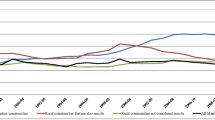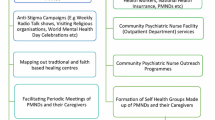Abstract
Purpose
This study aims to estimate, apply, and validate a model of the risk of serious mental illness (SMI) in local service areas throughout New Zealand.
Methods
The study employs a secondary analysis of data from the Te Rau Hinengaro Mental Health Survey of 12,992 adults aged 16 years and over from the household population. It uses small area estimation (SAE) methods involving: (1) estimation of a logistic model of risk of SMI; (2) use of the foregoing model for computing estimates, using census data, for District Board areas; (3) validation of estimates against an alternative indicator of SMI prevalence.
Results
The model uses age, ethnicity, marital status, employment, and income to predict 92.2 % of respondents’ SMI statuses, with a specificity of 95.9 %, sensitivity of 16.9 %, and an AUC of 0.73. The resulting estimates for the District Board areas ranged between 4.1 and 5.7 %, with confidence intervals from ±0.3 to ±1.1 %. The estimates demonstrated a correlation of 0.51 (p = 0.028) with rates of psychiatric hospitalization.
Conclusions
The use of SAE methods demonstrated the capacity for deriving local prevalence rates of SMI, which can be validated against an available indicator.

Similar content being viewed by others
References
Kessler RC, Üstün T (2008) The World Health Organization mental health survey. Cambridge University Press, Cambridge
Kessler RC, Üstün TB (2004) The World Mental Health (WMH) Survey initiative versions of the World Health Organization (WHO) Composite International Diagnostic Interview (CIDI). Int J Methods Psychiatr Res 13(2):93–121
Heady P, Clarke P, Brown G, Ellis K, Heasman D, Hennell S et al (2003) Model-based small area estimation series no. 2. Small area estimation project report: Office for National Statistics, UK
Hudson CG (2009) Validation of a model for estimating state and local prevalence of serious mental illness. Int J Methods Psychiatr Res 18(4):251–264
Oakley Browne MA, Wells JE, Scott KM (eds) (2006) Te Rau Hinengaro: the New Zealand Mental Health Survey. New Zealand Ministry of Health, Wellington
Mental Health Commission (1998) Blueprint for mental health services in New Zealand: how things need to be. Mental Health Commission, Wellington
Ministry of Health (1994) Looking forward, strategic directions for the mental health services. Ministry of Health, Wellington
Oakley-Browne MA, Joyce PR, Wells JE, Bushnell JA, Hornblow AR (1989) Christchurch Psychiatric Epidemiology Study, part two, six month and other period prevalences of specific psychiatric disorders. Aust Nz J Psychiatry 23:327–340
Ministry of Health (2005) Te Tahuhu—improving mental health 2005–2015: the second New Zealand mental health and addiction plan. Ministry of Health, Wellington
Ministry of Health (2006) Te Kokiri—the mental health and addiction action plan 2006–2015. Ministry of Health, Wellington
Schaible WL (1996) (ed) Indirect estimators in US federal programs. Springer, New York
Jarjgura D, McCord G, Holzer CE, Champney TF (1993) Synthetic estimation of the distribution of mentally disabled adults for allocations to Ohio’s mental health board areas. Eval Program Plann 16:305–313
Kamis-Gould E, Minsky S (1995) Needs assessment in mental health service planning. Adm Policy Ment Health 23(1):43–58
Hudson CG (1998) An interdependency model of homelessness: the dynamics of social disintegration. Edwin Mellen, Lewiston
Bajekal M, Scholes S, Pickering K, Purdon S (2004) Synthetic estimation of healthy lifestyles indicators: stage 1 report. National Center for Social Research, Department of Health (UK)
US, SAMHSA, Office of Applied Studies (2004, 2005) National survey on drug use and health, 2004 and 2005
Li F, Zaslavsky AM (2009) Small-area estimation of mental illness prevalence for schools. Department of Health Care Policy, Harvard Medical School, Boston
Lora A, Bezzi R, Erlicher A (2007) Estimating the prevalence of severe mental illness in mental health services in Lombardy (Italy). Community Ment Health J 43(4):341–357
Kessler RC, Berglund P, Demler O, Jin R, Walters EE (2005) Lifetime prevalence and age-of-onset distributions of DSM-IV disorders in the National Comorbidity survey replication. Arch Gen Psychiatry 62:593–598
Oakley Browne MA, Wells JE, Scott KM (eds) (2006) Te Rau Hinengaro: the New Zealand Mental Health Survey. New Zealand Ministry of Health, Wellington
Demyttenaere K, Enzlin P, Dewe W, Boulanger B, De Bie J, De Troyer W (2001) Compliance with antidepressants in a primary care setting, 2: the influence of gender and type of impairment. J Clin Psychiatry 62:34–37
Leon AC, Olfson M, Portera L, Farber L, Sheehan DV (1997) Assessing psychiatric impairment in primary care with the Sheehan Disability Scale. Int J Psychiatry Med 27:93–105
Hudson CG (2005) Socioeconomic status and mental illness: tests of the social causation and selection hypotheses. Am J Orthopsychiatry 75(1):3–18
Field M (2011) Excel data spreadsheet. New Zealand National Health Board, Ministry of Health, Wellington
Collett D (1991) Modelling binary data. Chapman & Hall, London
Sofroniou N, Hutcheson GD (2002) Confidence intervals for the predictions of logistic regression in the presence and absence of a variance–covariance matrix. Understanding stat I(1):3–18
Loether HJ, McTavish DG (1980) Descriptive and inferential statistics, 2nd edn. Allyn & Bacon, Boston
Hudson CG, Soskolne V (2012) Disparities in the geography of serious mental illness in Israel. Health Place. doi:10.1016/j.healthplace.2012.02.008
Hudson CG (2012) Declines in mental illness over the adult years: an enduring finding or methodological artifact? Aging Ment Health. doi:10.1080/13607863.2012.657157
Acknowledgments
The authors would like to acknowledge the consultative assistance provided by: Peggy Fairbaine-Dunlop, Foundation Professor of Policy Studies, Institute of Public Policy, AUT University, Auckland, NZ; Monique Faleafa, National Manager, La Va, Te Pou, Auckland, NZ; Te Kani Kingi, Director, The Academy for Maori Scholarship and Research, Massey University, Wellington, NZ; and Jane Vanderpyl, Research and Evaluation Manager, Te Pou, Auckland, NZ. The gracious sponsorship of the Auckland University of Technology, as well as the partial financial assistance of the School of Graduate Studies, Salem State University, are also acknowledged. The authors note the generous assistance of the New Zealand Ministry of Health in providing access to the Te Rau Hinengaro and New Zealand Health Survey data sets, as well as supplemental hospitalization data, which they have funded. The role of the New Zealand Crown as copyright owner is hereby acknowledged. This report does not necessarily represent the viewpoints of any individual or institution acknowledged above.
Conflict of interest
The authors declare that they have no conflict of interest.
Author information
Authors and Affiliations
Corresponding author
Appendices
Appendix 1
See Table 5.
Appendix 2
Syntax program for computation of SMI rates for District Board areas, based on results from estimated logistic model, using census data:
compute smidhb = −5.27955 + (age16_29p × 2.30678894) + (age30_49p × 2.28344888) + (age50_64p × 1.89572214) + (age65_plusp × 0.00000000) + (marriedp × −0.60126291) + (sepdivp × 0.31067703) + (marnevp × 0.00000000) + (employp × −0.51198054) + (emp_unempp × 0.54605975) + (emp_notlabforp × 0.00000000) + (finc_lthalfmedp × 0.85339089) + (finc_half_medp × 0.62929413) + (finc_med_plushalfp × 0.24669290) + (finc_above1_5medp × 0.00000000) + (ethnicity_maorip × 1.27175039) + (ethnicity_pacificp × 0.90615763) + (ethnicity_asianp × −0.25910878) + (ethnicity_euro_otherp × 1.04488877).
execute.
compute smidhb2 = exp(smidhb).
execute.
compute Est_smidhb = smidhb2/(1 + smidhb2).
execute.
Key: Smidhb—logit for SMI for each area; smidhb2—odds ratio for SMI; Est_smidhb—probability/proportion of smi. Other variable names represent the categories of the various predictors.
Note: A separate program is used for computation of asymptotic standard errors and confidence intervals, available upon request. (Parts of this section were adapted from an earlier study of one of the authors [4]).
Rights and permissions
About this article
Cite this article
Hudson, C.G., Abbott, M.W. Modeling the geographic distribution of serious mental illness in New Zealand. Soc Psychiatry Psychiatr Epidemiol 48, 25–36 (2013). https://doi.org/10.1007/s00127-012-0519-4
Received:
Accepted:
Published:
Issue Date:
DOI: https://doi.org/10.1007/s00127-012-0519-4




